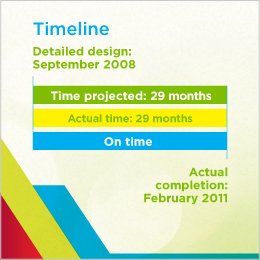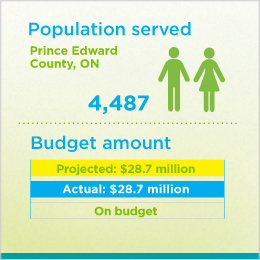This is part of a series of case studies on wastewater projects funded by the FCM's Green Municipal Fund. Each case study provides technical information, project details and tips on best practices.
Project overview
To help meet phosphorus discharge targets set by the Bay of Quinte Remedial Action Plan and to sustainably handle both projected growth in the Picton-Hallowell urban area and septage from residents in the surrounding rural areas, Prince Edward County, ON, constructed a new pumping station and a new wastewater treatment plant (WWTP). The existing plant in the Town of Picton (in Prince Edward County), built in 1947, was approaching its rated capacity. Further in-service upgrades would have been difficult because of aging components, land use constraints and aspects of plant layout that limit the capacity to handle increasing peak flows. The new WWTP provides a greater level of wastewater treatment and meets more stringent effluent criteria by replacing chlorination with tertiary filtration and ultraviolet (UV) disinfection. The plant was built and is operated under the county's full cost recovery approach to municipal water and wastewater infrastructure — an approach complemented by continual promotion of water conservation.



Reasons for the project
- The existing facility was reaching the end of its service life.
- The county had increased capacity requirements. The county wanted to meet targets for phosphorus set out by the Bay of Quinte Remedial Action Plan.
Innovative aspects of the project
- The project has improved the environmental sustainability of the community.
- Design-build is a solid approach for procurement and can fast-track construction during tight economic times.
- The municipality did an excellent job managing the project, from the feasibility study to the design-build process.
Best practices and key lessons
The municipality's experience with this project demonstrates some best practices and key lessons that can inform similar projects.
Engage early and broadly
- The municipality formalized the role of community members through a public works subcommittee and maintained regular engagement with practitioners, decision makers and the public through online status updates, press releases, a substantial milestone completion ceremony and a grand opening.
Use integrated teams and processes
- Involve operations staff in the design process from the start to ensure that design choices are optimal for ongoing facility operation. For example, cost cutting at the design stage may result in choices that are more laborious and time-consuming once in operation. Having input from operations staff can help in avoiding such mistakes.
Use alternatives to lowest-bid procurement
- A conventional tendering approach yielded bids that were significantly higher than the project budget. After offering bidders the opportunity to include facility operation in their bids (whereby the bidders would invest capital, which would be offset by future income), the municipality ultimately chose a design-build approach and worked with the successful bidder to reduce the costs to an acceptable level. This approach allowed the contractor and consulting engineer to work together to identify technical solutions and resolve construction issues. The arrangement reduced capital costs by producing a design tailored for cost-effective construction. The design-build team and the municipality also worked together in a value-engineering exercise to determine which aspects of the project could be eliminated or modified without impacting the project goals.
Project benefits
This project yielded a number of environmental, social and economic benefits.
Environmental benefits
Improved effluent quality: Through the addition of tertiary treatment and UV disinfection, the new WWTP provides higher quality effluent compared to the old plant.
Reduced hazardous residuals: UV technology has replaced chlorination for disinfection.
Reduced odour pollution: The new plant includes an odour-control system, which has eliminated odour emissions, improving air quality.
Social benefits
Improved public safety: The new facility is fenced and has security alarms to minimize crime and accidents.
Improved service delivery: The new WWTP provides more reliable treatment than the old facility, allowing for an overall reduction in bypasses and effluent non-compliance events. In addition, the plant has greater capacity to accommodate anticipated growth. It can also serve users whose households are not connected to the sewage collection system, providing a convenient and affordable means of septage disposal.
Creation of public space: Demolition of the old plant has improved the aesthetics of the surrounding space. The municipality plans to revitalize the space by turning it into parkland. Furthermore, the new plant is located further away from public recreation areas.
Protection and improvement of public health: With the new plant producing higher quality effluent, residents will have access to higher quality water.
Economic benefits
Increased potential to attract new businesses: By increasing the treatment and reserve capacity, the county will be able to serve additional businesses.
Increased potential to attract new residents: By increasing the treatment and reserve capacity, the county will be able to support a growing community.
More efficient operation: System automation through SCADA (supervisory control and data acquisition) allows for more efficient operation of equipment.

Technical highlights
This project was a new facility. Technical highlights are current as of 2013.
Municipal population: 25,258
Urban/rural: urban
Treatment
- Before: Conventional activated sludge
- After: Extended aeration activated sludge
Disinfection
- Before: Chlorine disinfection system
- After: UV disinfection system
Biosolids management: Stored liquid biosolids are treated and thickened to produce dewatered biosolids, which are hauled away from Prince Edward County to either a landfill or a composting facility.
Annual average daily flow (AADF)
- Before: 4.3 MLD (million litres per day)
- After: 2.9 MLD
Design capacity
- Before: 5.4 MLD
- After: 6 MLD
Per cent of total capacity used for AADF
- Before: 79 per cent
- After: 48 per cent
Total suspended solids (TSS)
- Before: 9.6 mg/L
- After: 2.4 mg/L
Project contact information
Don Caza
Director of Water and Wastewater Services
County of Prince Edward, ON
T. 613-476-2148, ext. 4501
Kayla Beach
Compliance Supervisor
County of Prince Edward, ON
T. 613-476-2148, ext. 4505
Want to explore all GMF-funded projects? Check out the Projects Database for a complete overview of funded projects and get inspired by municipalities of all sizes, across Canada.

